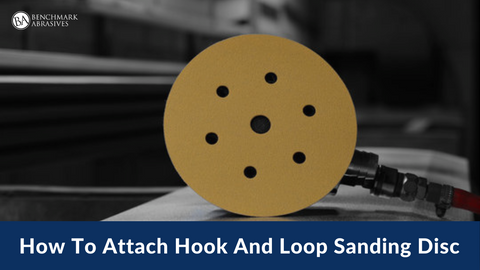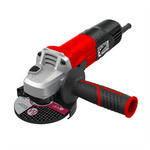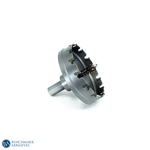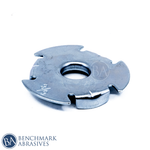
How To Attach Hook And Loop Sanding Disc

A powered sander uses two types of sandpaper or discs to attach: PSA, or pressure-sensitive adhesive, and hook-and-loop, often referred to as Velcro. This article is all about attaching a hook and loop sanding disc to a powered sander. Let’s begin by defining both terms for better understanding.
PSA Sandpaper Vs Hook and Loop Sanding Disc
PSA sandpaper, often known as pressure-sensitive adhesive sandpaper, is particularly popular in sanding discs. The PSA sanding disc is utilized by peeling off the adhesive-coated back. After peeling, simply apply hard pressure to the sandpaper, and it will adhere to the disc.
On the other hand, the hook and loop sanding disc has a Velcro-like base. It contains hooks and loops for attaching sandpaper to a machine like a random orbital sander or a disc sander. Tiny hooks wrap around tiny loops to build a tight connection, which holds the sandpaper firmly to the power tool's surface. The hooks grasp the loops and bind them together when the two are pressed together. This makes changing the sandpaper incredibly simple.
How To Attach a Hook and Loop Sanding Disc
Let's take a closer look at the process now that we've covered the sandpaper. There are pads and sandpaper. There are hooks on one and loops on the other. A Velcro tab on your sneakers works the same way. Loops on the sandpaper allow it to be attached to hooks on the pads of a random orbit sander, for example.
The sandpaper loops are smooth, and the hooks on the sander pads are rough; when squeezed together, the hooks latch around the loops, and the sandpaper is kept securely in place. Place the sandpaper (with the tiny loops) on the sander backing pad (with the tiny hooks), apply a little pressure, and connect the two. Simply peel the sandpaper off like a Velcro belt or shoelace to remove it.
Advantages Of Hook And Loop Sanding Disc
- Quick And Simple Replacement – It's very easy to replace a hook and loop sanding disc, simply take it out and put a new one in its place.
- Secure Bond – The PSA sandpaper would slip off due to weak adhesives. It's quite unlikely that the hooks will fall off the loops while using hook-and-loop sandpaper.
- Easily Available – Hook and loop sanding disc is available in a wide range of grit numbers. It's simple and quick to change from a 110 to a 220 or higher grit as needed.
- Versatile – Almost all types of sanders are compatible with hook-and-loop sanding discs.
- Highly Effective for Drywall – With their strong grip, quick changeability, and smooth finish, hook-and-loop discs are widely regarded as one of the best for drywall sanding, especially when consistency and surface quality matter most.
Here are five pointers to keep hook and loop sanding discs from flying away:
- Always use a high-quality hook and loop sanding disc
- Slightly move a sander on a surface
- Avoid applying too much force to the sander
- Sanding discs with hooks and loops should be used flat on a surface
- When you're not using the sander, store it sideways
Additional Tips For Using a Hook and Loop Disc For Best Results
The following are some additional tips to consider for using a hook and loop sanding disc for best results:
-
Clean surface: ensure that the surface of the backing pad and sanding disc is clean. Remove all the debris to ensure a strong and smooth connection between the pad and the sanding disc.
-
Pressure: ensure to apply even pressure when attaching the hook and loop pad to the sanding disc, creating a strong connection. Make sure that the hooks are properly attached to the loops for stronger and smoother results.
- Storage: ensure to store your sander with the backing pad exposed, which helps to prevent loops from getting clogged or flattened.



































































